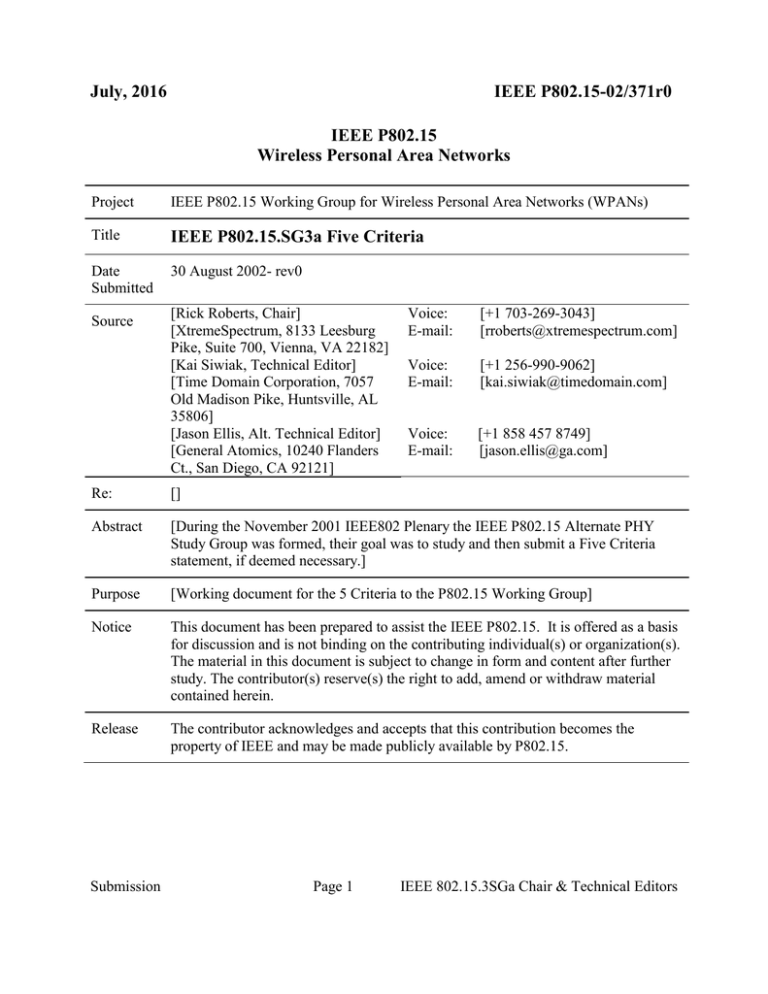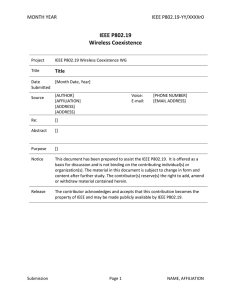July, 2016 IEEE P802.15-02/371r0 IEEE P802.15 Wireless Personal Area Networks
advertisement

July, 2016 IEEE P802.15-02/371r0 IEEE P802.15 Wireless Personal Area Networks Project IEEE P802.15 Working Group for Wireless Personal Area Networks (WPANs) Title IEEE P802.15.SG3a Five Criteria Date Submitted 30 August 2002- rev0 Source [Rick Roberts, Chair] [XtremeSpectrum, 8133 Leesburg Pike, Suite 700, Vienna, VA 22182] [Kai Siwiak, Technical Editor] [Time Domain Corporation, 7057 Old Madison Pike, Huntsville, AL 35806] [Jason Ellis, Alt. Technical Editor] [General Atomics, 10240 Flanders Ct., San Diego, CA 92121] Voice: E-mail: [+1 703-269-3043] [rroberts@xtremespectrum.com] Voice: E-mail: [+1 256-990-9062] [kai.siwiak@timedomain.com] Voice: E-mail: [+1 858 457 8749] [jason.ellis@ga.com] Re: [] Abstract [During the November 2001 IEEE802 Plenary the IEEE P802.15 Alternate PHY Study Group was formed, their goal was to study and then submit a Five Criteria statement, if deemed necessary.] Purpose [Working document for the 5 Criteria to the P802.15 Working Group] Notice This document has been prepared to assist the IEEE P802.15. It is offered as a basis for discussion and is not binding on the contributing individual(s) or organization(s). The material in this document is subject to change in form and content after further study. The contributor(s) reserve(s) the right to add, amend or withdraw material contained herein. Release The contributor acknowledges and accepts that this contribution becomes the property of IEEE and may be made publicly available by P802.15. Submission Page 1 IEEE 802.15.3SGa Chair & Technical Editors July, 2016 IEEE P802.15-02/371r0 IEEE P802.15 High Rate Wireless Personal Area Networks Study Group Functional Requirements Standards Development Criteria The IEEE P802.15 Alternate PHY Study Group for Wireless Personal Area Networks (WPANs) reviewed and completed the required IEEE Project 802 Functional Requirements, Standards Development Criteria (a.k.a. the Five Criteria). The IEEE P802.15 SG3a Five Criteria response is in Italics below. 1. BROAD MARKET POTENTIAL a) Broad sets of applicability The increasing popularity of wearable, hand-held computing, communicating devices, consumer electronics, and the proliferation of peripheral devices for them, has made clear that there will be broad based demand for these types of devices and for connectivity between them. Wireless connectivity between these devices will make them easier to use, and more useful. Since the next wave of these devices will need to support multimedia and large file applications, the next wave of wireless connectivity will require data rates faster than is currently available. Examples of applications demanding the proposed faster bit rates include time-dependant large file transfers, multiple simultaneous instances of high definition audio/video streaming and cable replacement. Examples of devices which can be connected include computers, computer peripherals (similar to USB 2.0's 480 Mbps capability), PDA/HPCs, printers, set top boxes, information kiosks, image displays, virtual reality games, DVD players, and camcorders (similar to IEEE 1394's 400 Mbps capability). The wireless capability will provide better user experiences, functionality, efficiency, productivity, mobility, portability and communications. b) Multiple vendors and numerous users The breadth of membership of this Alternative PHY Study Group demonstrates the interest in providing an alternate PHY for the 802.15.3 basic MAC. Members include international wireless industry leaders, academic researchers, semiconductor manufacturers, system integrators, consumer electronics companies and corporate end users. Individuals from more than 33 companies participated in drafting this PAR. The target user base will be large as indicated by the growing demand for multimedia connected PDAs, HPCs, digital imaging, display, digital video and digital audio devices. This project also encourages the development of new categories of products in conjunction with the trend to extend high bandwidth within the personal space. c) Balanced costs The standard for the 802.15.3 Alternate PHY will be developed with the aim that the connectivity costs will be a reasonably small fraction of the cost of the target devices previously mentioned. Submission Page 2 IEEE 802.15.3SGa Chair & Technical Editors July, 2016 IEEE P802.15-02/371r0 2. COMPATIBILITY IEEE 802 defines a family of standards. All standards shall be in conformance with IEEE 802.1 Architecture, Management and Inter-working. All LLC and MAC standards shall be compatible with ISO 10039, MAC Service Definition, at the LLC/MAC boundary. Within the LLC Working Group there shall be one LLC standard, including one or more LLC protocols with a common LLC/MAC interface. Within a MAC Working Group there shall be one MAC standard and one or more Physical Layer standards with a common MAC/Physical layer interface. Each standard in the IEEE 802 family of standards shall include a definition of managed objects, which are compatible with OSI systems management standards. Note: This requirement is subject to final resolution of corrections and revision to current ISO 10039, currently inconsistent with ISO 8802 series standards. The MAC (Medium Access Control) Layer of the Alternate PHY Standard will be compatible with the IEEE 802 requirements for architecture, management, and inter-networking and will be based upon the IEEE802.15.3 MAC. 3. DISTINCT IDENTITY a) Substantially different from other IEEE 802 standards. The orientation towards high rate multi-media applications, with their related QoS requirements, requiring data rates of 110 Mbps and higher, is currently not being pursued by any other wireless Standards Task Group. b) One unique solution per problem (not two solutions to a problem). The proposed supplement is addressing a unique solution for an emerging high rate multi-media market. c) Easy for the document reader to select the relevant specification. The proposed Alternate PHY Standard will be a distinct document with clearly distinguishable specifications. 4. TECHNICAL FEASIBILITY a) Demonstrated system feasibility There have been sufficient test results, numerous demonstrations, and simulations to indicate that the high data rates, quality of service, power management, low power consumption, spectral coexistence management, and PHY management services objectives of the Alternate PHY are feasible. b) Proven technology, reasonable testing There are examples of existing technology which will allow design and fabrication of these radio systems. Error performance testing and simulations at the data rates and distances defined by a WPAN indicate that the performance goal is feasible. c) Confidence in reliability Submission Page 3 IEEE 802.15.3SGa Chair & Technical Editors July, 2016 IEEE P802.15-02/371r0 The air interface protocol will be designed to meet commercial reliability standards. The data from existing products and prototypes representing the candidate approaches provide confidence in the reliability of the proposed solutions. 5. ECONOMIC FEASIBILITY a) Known cost factors, reliable data Comparison of the candidate concepts to systems developed for P802.15.3 indicates the cost will be similar. b) Reasonable cost for performance Based on test results, prototype solutions, production and implementation projections, the size, cost, and power requirements will be met. c) Consideration of installation costs The Alternate PHY standard objectives will have no impact on installation costs. Submission Page 4 IEEE 802.15.3SGa Chair & Technical Editors


